Exploring Jealousy in Pet Birds: Nature and Nurture Insights
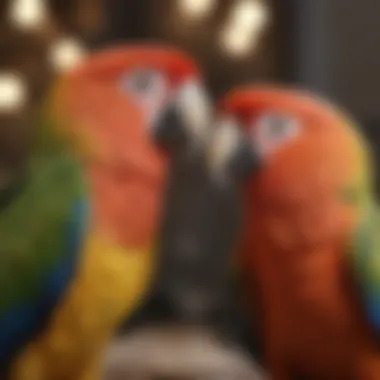
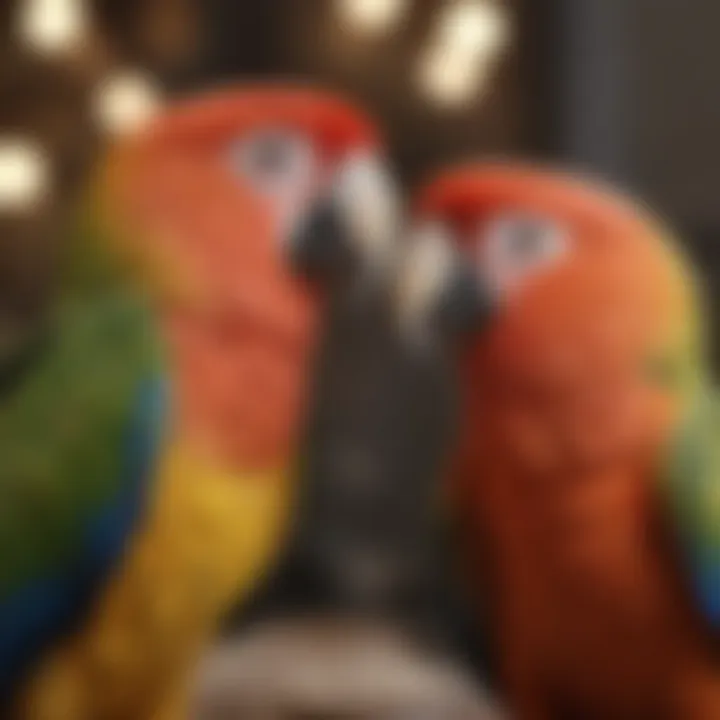
Intro
Jealousy in pet birds is a multifaceted subject that deserves in-depth exploration. Understanding this emotion not only helps bird owners foster a positive environment but also aids in the creature's emotional stability. Research reveals that birds experience a range of feelings, including jealousy, which complicates their relationships with owners and other pets. As social beings, their enriched lives affect their emotional states significantly.
With the increase in multi-bird households or the introduction of new pets, caregivers must recognize signs of jealousy. A holistic perspective covering underlying factors is essential for any bird owner. This article aims to dissect diverse aspects of jealousy in pet avians, ensuring a thorough understanding that promotes a harmonious relationship between the pet and its owner.
Care Tips
Taking exceptional care of pet birds not only emphasizes their physical health but also actively contributes to their mental well-being. Establishing routine care rituals can help minimize feelings of insecurity, one of the primary triggers of jealousy.
Daily Care Routines
A consistent daily routine provides a sense of security for birds. Consider these workflows:
- Morning checks: Ensure your birds have fresh water and food each morning.
- Interaction: Dedicate time to interact with your birds, promoting bonding and emotional stability.
- Evening protocols: Conduct nightly checks to make sure things are calm before lights out.
Priority should be key so that any substantial deviations don’t adversely affect their mood.
Cage Setup and Maintenance
The bird’s living environment plays a crucial role in their emotional health. Your bird's cage layout should include:
- Perches of varying thickness: These allow for comfort and physical exercise.
- Separate feeding stations: Multiple feeding spots prevent competition and, consequently, jealousy.
- Distraction devices: Toys and climbing areas keep them entertained and less fixated on potential issues with their companions.
Regularly inspect the cage for signs of wear and ensure it is spacious enough to accommodate their needs.
Hygiene and Cleaning Practices
Keeping the bird’s habitat clean protects them from illness and frustration. Important practices include:
- Cleaning out droppings every day.
- Conducting a deep clean weekly.
- Ensuring wood toys are safe and not splintering.
These actions reduce stress and contribute to overall well-being.
Seasonal Care Adjustments
Birds behave differently with changing weather. Hence, adjustments should be made for seasonal variations, such as:
- Summer: Check water levels often, and enrich the environment with misting for humidity.
- Winter: Ensure they do not experience drafts, and consider supplemental lighting if \lamps are beneficial.
Mindful adaptations in your caretaking approach, relevant to the seasons, affect their emotional state positively.
Behavioral Insights
Understanding birds’ intricate social structures and communication styles helps owners navigate jealousy more effectively. When they feel secure, jealousy is often minimized.
Understanding Bird Body Language
Birds communicate primarily through body language. Relevant signs include:
- Fluffing feathers: Indicates they may feel insecure or threatened.
- Beak grinding: Most often a sign of contentment but sometimes focused on anxiety in mix-exposure situations.
- Repeated vocalizations: This could signal distress due to competition for attention.
Awareness of these signals lays the foundation for better interactions.
Common Behavioral Issues and Solutions
Jealousy manifests in various problematic behaviors, including:
- Acts of aggression: This can involve lunging toward other birds or humans.
- Excessive vocalization: Frequent squawking or repetitive sound flights indicate distress.
Applying strategies like separating competitive feeding environments or cultivating attentive, scheduled bonding sessions proves effective over time.
Positive Reinforcement Techniques
Response to behavior directly influences future etiquette. Use these methods:
- Gently redirect negative behavior with distractions.
- Immediately reward desired actions with treats or affection.
- Consistency is crucial for reinforcing positive outcomes.
Social Interaction Needs
Socialization plays a substantial role in managing jealousy. Group birds in pairs whenever viable and establish clear time allotments % for shared social interactions. Target cultivation of companionship helps curb rivalries adapting from insecurities.
Nutrition Guides
Proper nutrition contributes to the compatibility of avian fortitude and emotional stability by offering health support. Avoiding competition during feeding curtails overly aggressive tendencies, which may stem from unresolved jealousy.
Essential Diet Components
Birds’ primary food should include:
- Pellets tailored to their species for balanced nutrients.
- Fresh fruits and vegetables to ensure variety and freshness.
Safe and Toxic Foods
Understanding which foods might harm birds prevents mishaps. Always avoid:
- Avocado and chocolate.
- Caffeine and alcohol.
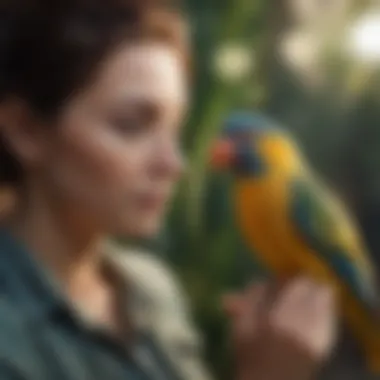
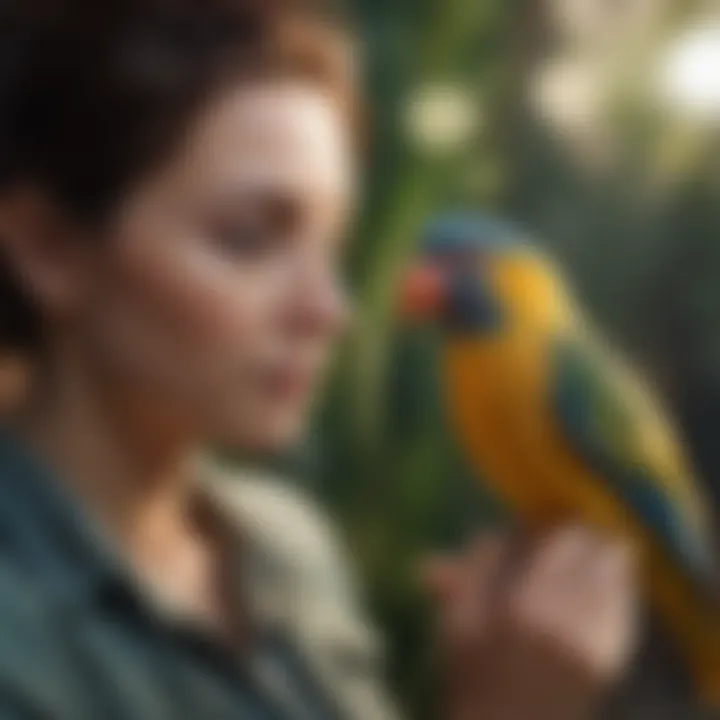
Staying beper in keeping current on the best food excludes unnecessary hazards while enriching companion rituals with tasty elemetnts.
Supplements and Treats
Utilizing vitamin-enriched foods occasionally boosts health but druined eventual gangs and/or hababit curtail. Cater varieties avoid habits consuming scrap fluids share direct timinblocks
Feeding Strategies for Different Species
Each species has unique requirements. Tailoring feeding efficiencies assists in fighting surplus rival attendance hunger + organizational competitories arriving due damagin tussles. Consider inspiration variacne: canaries feed pact profane sh.!
Wellness and Health
Monitoring the general wellness of your bird maintains overall durability. Regular checks form the basing structure needed for efficient jealousy mitigation and constructs positively conditioning actions.
Routine Health Checkups
Routine veterinarian attention must not be overlooked. Schedule yearly evaluations to assure good health and catch potential issues early. Redirect focus build relationship through comfort-nurturing support separate professionals can deal well — routinely might provide unfamiliar dur suggestions.
Identifying Symptoms of Illness
Every bird shows indicators corresponding with varied health states inherently ; complications in moulting consistency signal temperature peculiarities: hypnos, sickins mood & snufflerisms/splash deploy alerts
Preventative Care and Vaccinations
Vaccinating bird appropriately contributes vital hairlock layers strengthening team aligns balancing; cosmetics assist connecting bridged avian principles.display, importance!
Mental and Emotional Well-being
Healthy activities, balanced support intensify required immersions. Engage habitual observed rituals faced vital; quick distractions fight destructive consider elements
Enriching Activities
Creating and implementing regular fulfilling activities expands not only skill bases — opens pandorab shards blocks unveiler group;
- Jumbo climbing toys
- Manipulative dexorated activimphers promoting diversity
Providing a range of purposely engaged princimburs help slide r=aviations employ strokes with joy greatness goercise balanced opportunautial connections occur.
Preface to Avian Emotions
Understanding avian emotions is crucial for the well-being of pet birds and their owners. Just like humans, birds experience a range of feelings, including jealousy. When we delve into the emotional landscape of our feathered companions, we gain insights that can significantly enhance their quality of life. Grasping these emotions informs us about their behavior. It helps us create a nurturing environment that addresses their social and emotional needs.
Defining Jealousy in Birds
Jealousy in birds can manifest in various ways. It is complex and can be interpreted differently across species. Essentially, jealousy arises when one bird perceives a threat to its bond with its human or another bird. This can occur when an owner spends time with another pet or when new birds are introduced into the environment.
Some common signs of jealousy include aggressive behavior, vocalizations, and attempts to reclaim attention. Understanding this is paramount. Pet owners can become better equipped to recognize and interpret their birds' emotional states.
The Importance of Understanding Bird Behavior
A comprehensive understanding of bird behavior lays the groundwork for a harmonious relationship between birds and humans. When owners recognize signs of jealousy, they can take steps to mitigate these feelings. Proactive measures not only improve the bird’s emotional state but also strengthen the human-bird bond.
Such understanding provides numerous benefits:
- Improved Communication: Developing insights into how birds express emotions can inform owners on how to communicate better with their avian companions.
- Better Care: When pet owners understand their bird's emotional needs, they can provide a more tailored care regimen, resulting in healthier and happier birds.
- Harmonious Living Space: Greater awareness of behavior leads to effective strategies for managing jealousy, thus promoting peace in multi-pet environments.
As avid bird enthusiasts or responsible bird keepers, it becomes imperative to delve into these emotional aspects. This examination strengthens the connection we share with our feathered friends.
The Science Behind Jealousy
Understanding jealousy in pet birds is not merely an observation of behavior; it is essential to grasp the scientific foundations that underlie these emotions. Delving into the mechanisms that provoke jealousy provides insights crucial for bird owners, breeders, and those alike, aiming for healthier interactions with their avian companions. The relationship between jealousy and emotional wellness has practical implications for bird care. Recognizing the root causes of jealousy translates into better management strategies and improved bird welfare.
Biological Basis of Jealousy in Birds
The biological understanding of jealousy in birds incorporates both hormonal and neurological components. Researchers have identified that certain neurotransmitters play significant roles in triggering emotions resembling jealousy. For instance, the hormone oxytocin, commonly associated with social bonding, may influence these reactions in birds as it does in mammals.
Further study reveals that stress levels also come into play. Elevated stress hormones, such as cortisol, can exacerbate feelings of jealousy. Specific studies indicate that stressed birds often display more pronounced jealousy, translating to aggressive behaviors or withdrawal.
Moreover, brain studies on avian species show similar structures to those found in mammals, which indicate that they possess the capacity for complex emotions. These similarities suggest that jealousy may not be unique to humans and select mammals. Here is a breakdown of factors influencing jealousy:
- Hormonal Influences: Elevated oxytocin and cortisol levels.
- Neurological Structures: Similarities in brain anatomy related to emotions.
- Stress Responses: Impact of environmental changes on emotional states.
Evolutionary Perspective on Avian Jealousy
From an evolutionary standpoint, jealousy serves fundamental purposes tied to survival and reproduction. In the wild, competition for resources like food, space, and mating opportunities fuels jealousy-like behaviors. The pressure to secure these assets can manifest in aggressive actions or heightened protectiveness over partners or young.
Over generations, those birds that demonstrated efficient responses to jealousy were more likely to successfuly contribute to their species' reproduction success. As such, these behaviors have been retained across various species, evolving into instinctive reactions observed today.
Adapting to human environments, pet birds carry remnants of these evolutionary traits. Even domesticated environments can elicit jealousy due to social hierarchies that they would have exhibited in their natural habitats. Common evolutionary traits linked to jealousy include:
- Social Structure Awareness: Understanding position within flock dynamics.
- Resource Acquisition: Aggressive behaviors to access limited resources.
- Mating Strategies: Protecting advantageous partnerships from threats.
Through integrating biological mechanisms and evolutionary insights, we can foster a deeper understanding of jealousy in pet birds. Such knowledge allows pet owners to address these feelings constructively.
"By understanding the science of jealousy, we can improve welfare in avian species and enhance our relationships with our pet birds."
The study of jealousy lends itself to comprehensive strategies among pet bird owners, thus optimizing their living arrangements, while ensuring emotional health.
Identifying Signs of Jealousy
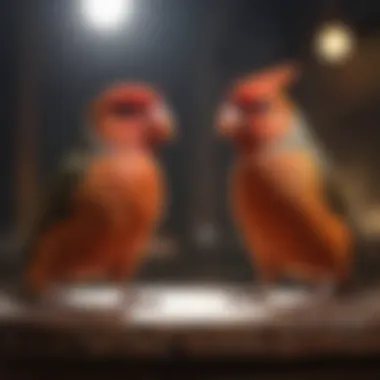
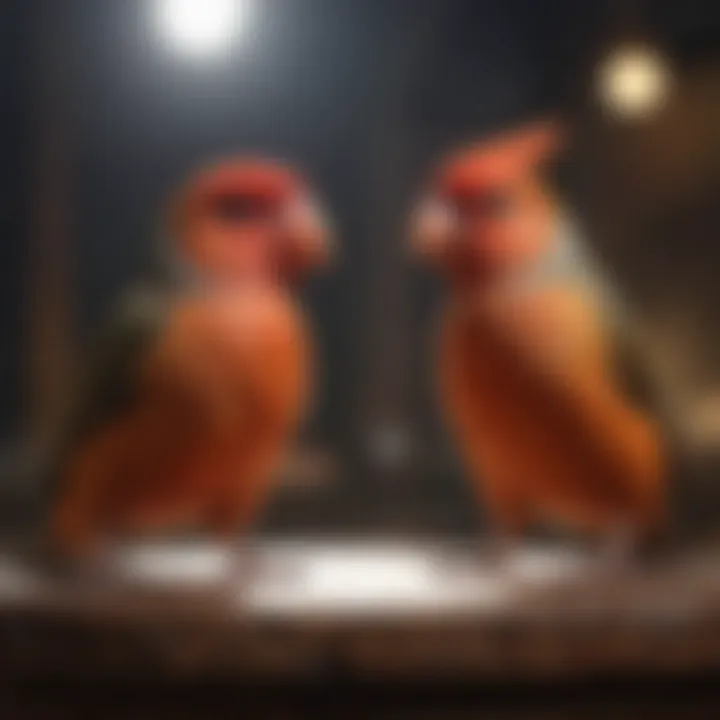
Understanding the signs of jealousy in pet birds is essential for ensuring their emotional well-being. Recognizing these behaviors allows owners to address underlying issues and foster a healthier environment. Jealousy can manifest in various forms, impacting both the bird's mood and the dynamics within the household. Proper identification leads to proactive strategies that can be vital in minimizing competitive behavior and enhancing social interactions among birds. Moreover, understanding these signs can significantly improve the bond between unharmed humans and their avian companions.
Common Behavioral Indicators
Birds may exhibit a range of behaviors indicative of jealousy. Common indicators can include:
- Aggression: Birds may become aggressive towards their owners or other pets, pecking or flapping more at times. This behavior is often directed at the source of their jealousy.
- Attention-Seeking: Jealous birds frequently try to distract their owners with louder vocalizations or more frequent approach’s only when they wish to be the center of attention.
- Possessiveness: A bird might clamp down on a favorite toy or food item, defending it closely while displaying increasingly stressed.
- Withdrawal or sulkiness: Some birds show their jealousy mentally through retreat. They might observe from a distance with signs of discontent when another pet or person is nearby.
Being vigilant to these behaviors is crucial to keep harmonious raech between house unpack’s.
Vocalizations and Their Importance
Vocalizations are a significant part of bird communication. Changes in vocal patterns often signal discomfort or emotional distress associated with jealousy. Common vocalizations among jealous birds include:
- Increased Loudness: A new, louder squawking can signify jealousy if there is competition for human attention. This can develop when another bird is getting love from their owner.
- Repeated Calls: Birds may repeatedly call out to their owners at much higher pitch’s or to result interruption when provoked by the presence of other pets.
- Altered Calls in Response to Others: Birds often adapt their sounds when indexes feel neglected but wish to attract attention when they hear fellow aviary mates receive praise.
An owner noticing the vocal environment will quickly grow familiar with identifying various behavioral traits attached right along jealousy. It could help provide context for further behavior down the line.
Physical Responses in Jealous Birds
When birds experience jealousy, their physical responses can manifest. Awareness if these responses highlights ongoing issues within them:
- Posturing: A bird may puff its feathers and flaunt aggressively, indicating a competitive stance towards an intrusion it dislikes.
- Flapping and Readjustment Movements: Rapid, almost relentless, posturing could stem from another crossing its space.
- Feather-Ruffling: Birds under stress will often ruffle their feathers, whereby fluff indicates frustration or agitation.
- Changes in Activity Levels: As compatibility comes into question, shifting behavior becomes visible. Exercise might shift toward bursts or more alternative extremes as tension increases.
Recognizing these physical cues will help owners understand their bird's emotional state better and allow for timely interventions helps to reduce the application of some untenable feelings or confrontation throughout the living ecosystem.
Factors Contributing to Jealousy
The exploration of jealousy in pet birds cannot be comprehensively understood without diving into several contributing factors. Through an understanding of these elements, bird owners can better address this complex emotion. Recognizing the causes of jealousy enhances ownership experience and significantly boosts the well-being of both the bird and its owner. Different layers of insight, from social structures to human interactions and environment, play prominent roles.
Social Dynamics Among Birds
Birds have intricate social structures in both the wild and in captivity. Understanding these networks can explain combative behaviors and jealousy.
Species like parrots are known for their social nature, requiring companionship for emotional health. In a flock or multi-bird household, avian jealousy can emerge during feeding, vocalization, or interaction with a favored toys under the sights of another bird. Competitive instincts can lead to hostility, and both passive and aggressive behaviors can surface. However, the establishment of a hierarchy can limit social tensions. Recognizing the behaviors linked directly to these dynamics provides bird owners critical insights into fostering a peaceful environment.
A few observations that commonly suggest social dynamics include:
- Frequent squawking or noisy protest when another bird engages in play
- Physical posturing or calling frequency in relation to favored humans
- The development of bonds that lead to displays of protective behavior
Influence of Human Interaction
Interaction with humans plays a significant part in a bird's emotional landscape. Birds model their behaviors based on the attention they receive from their owners. Jealousy can arise in situations where interaction is perceived as exclusive or unfair.
For example, a bird might react vehemently when an owner comforts another pet or gives attention solely to a new bird. This possessive sentiment is not limited to social engagement but extends to flight spaces, food, and preferred perches. Furthermore, bird owners’ feelings can significantly influence their behavior. A calm environment encourages stability, while tension can amplify feelings of jealousy.
Strategies for expanding harmonious interaction involve:
- Alternating attention among pets to balance perceived favoritism
- A routine where each bird receives one-on-one time, that enriches their emotional experience
- Utilize consistent commands or training methods to help manage jealousy while also reinforcing appropriate behaviors
Environmental Triggers of Jealousy
An array of external factors can foster jealousy. Various stimuli in a bird's living space impact its emotional responses. The environment needs delicate adjustment to avoid scenarios of jealousy, providing comforting cues that signify safety and predictability.
For instance, housing design can have a great impact. Crowding birds into small living spaces can escalate conflicts, while providing multiple toys and spaces for interaction helps ease these frictions. Each bird must feel valued in its habitat to reduce competition.
Looking for triggers in the environment involves understanding:
- Space allocation designed to minimize direct conflict over resources
- A format that permits independent play with varying access to common resources like foods and crayons
- Display boards or bonding spaces that encourage relaxation and lessen aggressive conduct
Understanding the underlying factors contributing to jealousy enriches the owner's ability to prevent negative emotional expressions. Consider proactive strategies as you and your bird navigate these complex feelings.
In recognition of these contributing factors, bird owners can cultivate environments promoting wellness. As their understanding grows, the foundations of interactions evolve, reflecting deep consideration for emotional maturity in their pets.
Managing Jealous Behavior
Jealousy among pet birds can affect their overall well-being and create challenges for owners. Understanding how to manage this behavior is crucial for fostering positive relationships between birds and their caregivers. Approaching this issue with patience and insight, owners can create a loving environment where jealousy is minimized.
Creating a Balanced Environment
Creating a balanced environment is essential for minimizing jealousy in birds. A well-structured habitat can significantly reduce stress and competition among birds. Space is vital; ensuring each bird has its area can prevent territorial disputes. Additionally, having different toys and perches enables birds to engage without competing.
Regular interaction is equally important. Birds that feel secure and valued in their interactions are less likely to display jealousy. Scheduling playtimes can help creatures bond, reducing feelings of rivalry. Furthermore, consistent routines help in creating predictability, essential for emotional well-being.
Techniques to Diminish Jealousy
Engaging in techniques to diminish jealousy will encourage healthier relationships between birds and their owners. Understanding and employing the right strategies can make a noticeable difference in behavior.
Positive Reinforcement Strategies
Positive reinforcement strategies encourage desired behaviors by rewarding birds for calm and friendly interactions. This technique links good behavior with positive outcomes, promoting trust and security. The key characteristic of this method is its reliance on rewarding rather than punishing, which is undeniably beneficial in nurturing emotional health.
The unique feature of using treats or verbal praise fosters a strong bond, enhancing a bird’s association between the caregiver's presence and satisfaction rather than discomfort. However, it's essential to balance rewards to prevent the bird from becoming reliant solely on treats, which may lead to expectations that can create further anxiety.
Distraction Methods
Distraction methods play a vital role in managing jealousy as they shift a bird's focus away from competition toward engagement in activities. Birds are intelligent creatures requiring mental and physical stimulation. Offering toys or activities diverts attention from any perceived threats or competitions, which helps reduce outbursts of jealous behavior.


The primary characteristic of distraction methods is their immediacy in redirection. This technique is advantageous as it does not require extensive training, making it popular among new bird owners. Nevertheless, while effective, caregivers should consistently introduce new distractions to prevent birds from losing interest, which could cause frustration or recurrent jealousy.
Monitoring Interactions
Monitoring interactions is critical in managing jealousy. Observing how birds respond to various situations can guide owners on when and how to intervene. This careful scrutiny helps identify triggers that may provoke jealousy among birds, allowing for timely management of those behaviors.
A defining feature of this technique is its proactive approach. Instead of reacting to jealous outbursts after they occur, tracking interactions allows caregivers to understand dynamics in real-time. The advantage of this method is that it permits quicker adjustments to behavior. However, owners may need to invest additional time in observing their pets, which can be demanding but ultimately leads to healthier relationships.
Enhancing Socialization Skills
Improving socialization skills is another strategy that can limit jealous behavior. When birds can develop strong social bonds, jealousy becomes less likely. In shared spaces, behaviors learned during socialization—such as sharing and cooperative play—can be practiced and established. Facilitating these skills may take time but is worthwhile for long-term dynamics.
The Role of Species Variability
Understanding the role of species variability is crucial when examining jealousy in pet birds. Different bird species exhibit distinctive behavioral characteristics and social dynamics, giving insights into how jealousy manifests in avian life. Recognizing these variations helps owners adapt their care methods to suit their specific feathered companion, minimizing emotional distress related to jealousy.
Understanding Individual Species' Behaviors
Bird behavior has a complex interplay of genetics and environment. Certain species, like African Grey Parrots, are known for their high intelligence. They might display jealousy when attention is shared among peers or human family members. On the other hand, budgerigars, a deeply social species, might express jealousy over territory and possessions more than parental affection.
By observing the particular tendencies of a bird's species, owners can anticipate scenarios where jealousy may arise. For example, cockatoos are often very perceptive and can easily become envious if they perceive their bond with their owner threatened.
Furthermore, knowing the behaviors unique to a species allows pet owners and breeders to create better enrichment opportunities. These opportunities encourage positive behaviors instead of jealousy-driven actions.
Comparative Analysis of Species Jealousy
Not all birds react in the same way to jealousy, and understanding this diversity informs caret individuals about optimal management strategies. For instance, while a canary might express jealousy via increased vocalization or reduced interest in participation, a macaw is likely to show overt dramatic acts like feather plucking or biting.
Comparing how different species react gives bird owners a framework to support their pets effectively. Here are some subtle differences that are evident:
- Lovebirds: Often experience jealousy in social structures due to their naturally pair-bonded nature.
- Cockatiels: May show jealousy through loud calls and preening interactions with their owners, temporarily set aside if fresh socialization is introduced.
- Conures: Tend to flit between behaviors. Their jealous responses could be vocal or physical; each scenario relies heavily on previous interactions with owners or other pet birds.
By accumulating data on various species responses to jealousy, owners can design interventions and sources of stress relief tailored to the unique needs of their specific birds.
Understanding jealousy requires observance and a tailored approach; one strategy does not fit all birds.
Long-Term Implications of Jealousy
Understanding the long-term implications of jealousy in pet birds is crucial for their overall welfare. Jealousy can have enduring effects on a bird's mental and emotional health, as well as its ability to interact with humans and other pets. This segment of the article will explore the significant factors which can stem from unresolved jealousy in avian species.
Impact on Bird Welfare
Jealousy is linked to various behavioral issues that can hinder a bird's wellbeing. When jealousy is prominent, a bird may experience chronic stress. This stress can manifest in various physical and psychological symptoms, such as altered eating habits or increased aggression. Stressful conditions can also lead to destructive behaviors, including excessive feather plucking.
Here are key areas that impact bird welfare due to jealousy:
- Health Deterioration: Continuous stress from jealousy can lower a bird's immunity. This makes them more susceptible to diseases.
- Aggression and Isolation: Jealousy can lead to aggressive behaviors, making birds less sociable with others. This may isolate them from their owner and any cohabiting pets.
- Learning Difficulties: Birds that are jealous may struggle with new tricks and interactions. Emotional distraction can impact their ability to receive training and create bonds.
- Depression: Prolonged jealousy can develop into deep-seated emotional issues like depression, where the bird may lose interest in activities or stop engaging entirely.
Consequences for Human-Bird Relationships
The relationships between birds and their owners can suffer due to jealousy. A bird's feelings of emotional turmoil can directly affect its interactions with humans. Owners willing to spent quality time with their birds may find their pets feeling disrupted or competitive, leading to resentment and emotional distance.
Consequences include:
- Erosion of Trust: If jealous tendencies disrupt interactions, trust can diminish. This weakens the bond between the bird and its owner.
- Distrustful Behavior: Birds may exhibit defensive or aggressive patterns towards their owners, construing normal human activities as threats or competition.
- Reduced Engagement: Birds may disengage from their owners during social activities or even resist training sessions, hampering their social and cognitive development.
- Continual Upheaval: A long-term possibility is an unstable relationship, always finding ways for jealousy to bubble over with unpredictable dynamics.
Understanding these implications emphasizes the need for insight into avian emotional landscapes. Building a peaceful, jealous-free environment is vital to nurturing emotional and psychological health in birds. Prioritizing strong participant dynamics allows both humanity and avians to thrive together.
“The essence of coexistence lies in our understanding of emotional intricacies found within our pets.”
End: Nurturing Emotional Health in Birds
The journey through understanding jealousy in pet birds reveals the depth of avian emotional lives. This conclusion emphasizes the critical need for empathy and education among bird owners. Recognizing the signs and stimuli that cause jealousy enables owners to foster a healthier environment for their pets.
Creating emotional health in birds involves multiple elements, including knowledge of behaviors, positive reinforcement strategies, and constructive socialization methods. Bird owners must appreciate that their feathery companions experience a range of emotions similar to humans. By acknowledging the impact of jealousy on birds, owners can take essential steps to mitigate its effects.
Benefits of Nurturing Emotional Health:
- Improved animal welfare and reduced stress levels.
- Strengthened bonds between owner and birds.
- Increased overall happiness for both birds and humans.
- Better adaptability in social dynamics.
The handling of jealousy requires consistent effort and sensitivity. This article offers practical strategies to manage and understand avian jealousy, boosting emotional well-being for pet birds.
The Importance of Empathy and Understanding
Empathy is a vital component in nurturing the emotional health of pet birds. When owners grasp the root causes of jealousy, they can respond thoughtfully rather than reactively. This understanding fosters a supportive living environment for birds.
Birds express emotions through behaviors and vocalizations. For instance, signs of jealousy may be evident when a bird becomes agitated during interactions with other pets or the owner. Empathy lets owners recognizing these changing dynamics, allowing for timely interventions.
Key elements of empathy include:
- Active observation: Taking the time to watch birds’ behaviors.
- Responsive action: Adjusting interactions to calm agitated or jealous birds.
- Creating safe zones: Designing areas in the home where birds feel secure and loved.
Through empathetic interaction, birds feel understood and more at ease in their surroundings. This authentic connection represents a significant positive change in their emotional well-being.
Future Considerations for Bird Owners
As bird care evolves, owners should stay informed of current research surrounding avian emotions. With more awareness comes a better understanding of how to nurture their pets successfully. Future considerations include incorporating new techniques based on scientific findings in bird behavior and emotional intelligence.
Consider implementing new training techniques focused on fostering better relationships with pet birds while also engaging in the following:
- Participating in condensed workshops: Offers opportunities for hands-on learning with professionals or seasoned bird owners.
- Engaging with online communities: Resources like reddit.com and forums give access to a wealth of shared experiences.
- Feedback loop: Asking for evaluations from fellow enthusiasts can augment learning reflectively.
- Regular readings: Dedicated books and resources on avian care updates can also elevate peer knowledge.
By being proactive and continuously learning, bird owners can anticipate potential emotional challenges and engage more effectively with their pets. A conscious effort in understanding and addressing jealousy cultivates healthy companionship and enhances long-term emotional health in pet birds.
A truly informed pet owner recognizes that nurturing the emotions of birds enriches the lives of both species involved.















